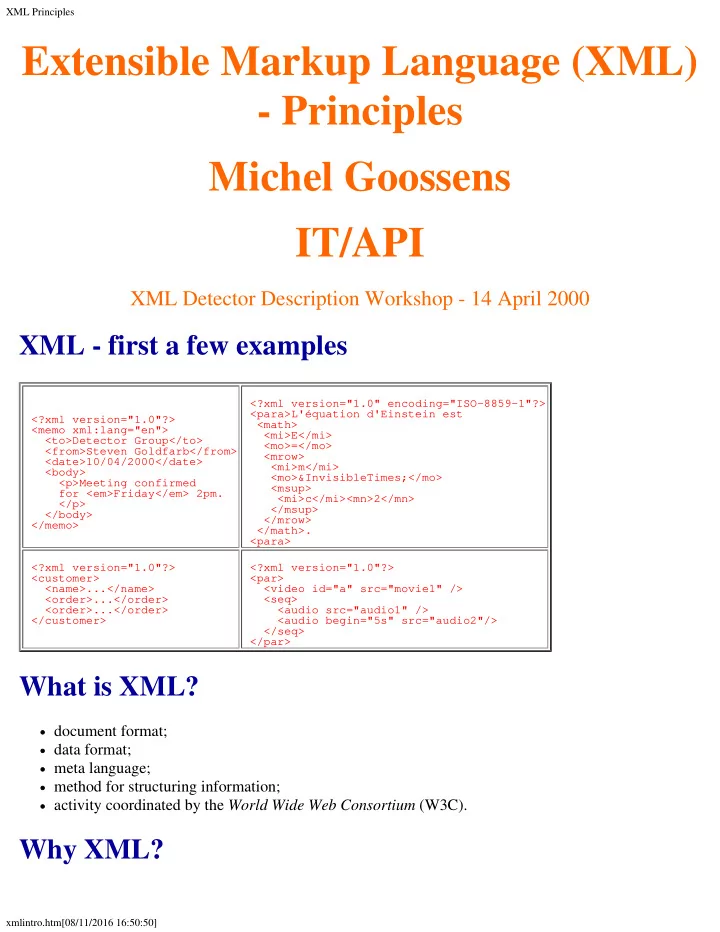

XML Principles Extensible Markup Language (XML) - Principles Michel Goossens IT/API XML Detector Description Workshop - 14 April 2000 XML - first a few examples <?xml version="1.0" encoding="ISO-8859-1"?> <para>L'équation d'Einstein est <?xml version="1.0"?> <math> <memo xml:lang="en"> <mi>E</mi> <to>Detector Group</to> <mo>=</mo> <from>Steven Goldfarb</from> <mrow> <date>10/04/2000</date> <mi>m</mi> <body> <mo>⁢</mo> <p>Meeting confirmed <msup> for <em>Friday</em> 2pm. <mi>c</mi><mn>2</mn> </p> </msup> </body> </mrow> </memo> </math>. <para> <?xml version="1.0"?> <?xml version="1.0"?> <customer> <par> <name>...</name> <video id="a" src="movie1" /> <order>...</order> <seq> <order>...</order> <audio src="audio1" /> </customer> <audio begin="5s" src="audio2"/> </seq> </par> What is XML? document format; data format; meta language; method for structuring information; activity coordinated by the World Wide Web Consortium (W3C). Why XML? xmlintro.htm[08/11/2016 16:50:50]
XML Principles I18N electronic publishing platform independent; language independent; media independent. Web applications exchange format between databases; managing a collection of documents; distributed document handling; client-side data manipulation; commercial transactions. The origins of XML 30 years of research in the area of document handling; important landmarks were: GML, Scribe; in ISO international standard: SGML (ISO 8879); 15 years experience with SGML; a popular SGML application: HTML; need for a richer and more specialised set of languages; a simplified version of SGML for the Web: XML. XML and the users can be adapted to all sorts of applications; uses a readable text-based syntax; easily parsable by machines; light-weight deployment; full I18N support; guaranteed interoperability: content, style, behaviour. XML and W3C World Wide Web Consortium over 400 members world-wide; develop the base technologies for the Web; openness and consensus. XML at the W3C xmlintro.htm[08/11/2016 16:50:50]
XML Principles XML Core WG : XML syntax (XML, namespaces, Xinclude, Xbase ); XML Linking WG : next generation hypertext ( Xpointer, Xlink ); XML Schema WG : successor for DTDs (much more general); XML Query WG : define a query language for XML (gather requirements); XSL WG : transformation and style sheet language ( XPath, XSLT, XSL-FO ); DOM WG : object-oriented API for XML. XML fundamentals XML is not a language, but a meta-language; XML supports an infinite number of languages for science, industry, business, etc.; all such XML-based languages can be handled by the same light-weight parser; two language syntaxes: markup language; document type definition language (DTD). XML as a markup language tree structure; element types; attributes: name-value pairs; identification of element instances by unique ID; entities; full I18N for names and content via Unicode (ISO/IEC 10646). Example <?xml version="1.0"?> <memo xml:lang="en" security="cern"> <to>Detector Group</to> <from>Steven Goldfarb</from> <date>10/04/2000</date> <body> <p>Meeting confirmed for <em>Friday</em> 2pm. </p> </body> </memo> The DTD syntax document type definition (defines type of documents); simplified version of SGML; defines the document grammar; defines element names, attributes and entities; makes it possible to verify documents. DTD example xmlintro.htm[08/11/2016 16:50:50]
XML Principles <!ELEMENT memo (to, from, date, subject?, body) > <!ATTLIST memo security (public | cern ) 'public'> <!ELEMENT to (#PCDATA) > <!ELEMENT from (#PCDATA) > <!ELEMENT date (#PCDATA) > <!ELEMENT subject (#PCDATA) > <!ELEMENT body (p+) > <!ELEMENT p (#PCDATA | em)* > <!ELEMENT em (#PCDATA) > Well-formed and valid documents a DTD is not obligatory; a document must at least be well-formed : elements correctly nested inside root element. if the document references a DTD it must also be valid : respect the specifications in the DTD. XML Schemas DTDs have limitations: too constraining (everything must be defined); no content typing (e.g., date, numeric range); non-XML syntax. XML Schemas structural constraints: type definitions, classes and sub-classes, content models, import, include; data typing: string, boolean, binary, uri, number, integer, decimal, real, date, time, timePeriod ; use XML syntax. Remarks XML only defines a syntax, no semantics; XML element names have no pre-defined meaning nor associated presentation; XML defines only content and structure, no behaviour. XML - Applications W3C specifications based on XML MathML : mathematical expressions; SMIL : Synchronized Multimedia Integration Languages; xmlintro.htm[08/11/2016 16:50:50]
XML Principles SVG : 2-D vector graphics; XHTML : XML definition of HTML; RDF : metadata; XSL : stylesheet language. Other languages using XML Dozens of XML-based languages exist already, and more are created almost dayly. WAP : Wireless Application Protocol; AML : Astronomical Markup Language; BIOML : Biopolymer Markup Language; GEML : Gene Expression Markup Language; X3D : 3-D graphics, virtual reality (VRML); MusiXML : music notation; VXML : vocal dialogues; CML : Chemical Markup Language; FpML : Financial products Markup Language; TEI : Text Encoding Initiative; DocBook : Computer documentation; etc. MathML example ( a + b ) 2 <msup> <apply> <mrow> <power/> <mo>(</mo> <apply> <mi>a</mi> <plus/> <mo>+</mo> <ci>a</ci> <mi>b</mi> <ci>b</ci> <mo>)</mo> </apply> </mrow> <cn>2</cn> <mn>2</mn> </apply> </msup> SMIL example <par> <video id="a" begin="6s" src="movie1" /> <img begin="id(a)(4s)" src="img" /> <seq> <audio src="audio1" /> <audio begin="5s" src="audio2" /> </seq> </par> par |--------------------------| 6s movie1 <----->|------------------| 4s img <--->|------------| audio1 5s audio2 |--------|<---->|----------| xmlintro.htm[08/11/2016 16:50:50]
XML Principles XML Namespaces modular design; use several XML grammers in the same document (without element name clashes). Example : <?xml version='1.0'?> ... <particles> <!-- Default namespace is set to HTML --> <table xmlns='http://www.w3.org/TR/REC-html40'> <tr><td>Particle</td><td>Mass</td><td>Details</td></tr> <tr> <td><em>neutron</em></td> <td>939.56 MeV</td> <td> <pdg xmlns="mypdgnamespace"> <!-- HTML namespace is no longer used --> <quarks>udd</quarks><lifetime>886.7 s</lifetime> <decay>p,e,anue</decay> </pdg> </td> </tr> </table> </particles> ... Style sheets Separate document style from content/structure: without modifications a document can be presented in different ways depending upon the reader, the output medium, the target application; a set of documents can be presented in a homogeneous way (house style); this has the advantage that one can maintain documents for the Web independent on platforms, performance, etc. CSS: Cascading Style Sheets Work with XML as well as with HTML. CSS 1: basic style components: fonts, colour, size, spacing, margins, etc.; CSS 2: fine-tune placement, dynamic loading of fonts, printing, audio output, I18N, tables, numbering, etc.; CSS 3: further extensions for CSS (selectors, user interface, colour specs) are being specified by the W3C styling WG. XSL: Extensible Stylesheet Language Works only with XML. XPath: address parts of an XML document; XSLT: transform XML documents; can generate toc, index, etc.; xmlintro.htm[08/11/2016 16:50:50]
Recommend
More recommend